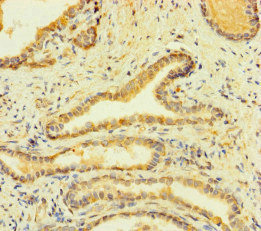![FACS analysis of MC/9 cells using GTX01480-07 Fc epsilon R1 alpha antibody [MAR-1] (APC). Solid lone : primary antibody Dashed line : isotype control antibody amount : 0.125 microg (5 microl) FACS analysis of MC/9 cells using GTX01480-07 Fc epsilon R1 alpha antibody [MAR-1] (APC). Solid lone : primary antibody Dashed line : isotype control antibody amount : 0.125 microg (5 microl)](https://www.genetex.com/upload/website/prouct_img/normal/GTX01480-07/GTX01480-07_20200428_FACS29_w_23053121_905.webp)
FACS analysis of MC/9 cells using GTX01480-07 Fc epsilon R1 alpha antibody [MAR-1] (APC). Solid lone : primary antibody Dashed line : isotype control antibody amount : 0.125 microg (5 microl)
Fc epsilon R1 alpha antibody [MAR-1] (APC)
GTX01480-07
ApplicationsFlow Cytometry
Product group Antibodies
TargetFCER1A
Overview
- SupplierGeneTex
- Product NameFc epsilon R1 alpha antibody [MAR-1] (APC)
- Delivery Days Customer9
- Application Supplier Note*Optimal dilutions/concentrations should be determined by the researcher.Not tested in other applications.
- ApplicationsFlow Cytometry
- CertificationResearch Use Only
- ClonalityMonoclonal
- Clone IDMAR-1
- Concentration0.2 mg/ml
- ConjugateAPC (Allophycocyanin)
- Gene ID2205
- Target nameFCER1A
- Target descriptionFc epsilon receptor Ia
- Target synonymsFCE1A, FCERIA, FcERI, high affinity immunoglobulin epsilon receptor subunit alpha, Fc IgE receptor, alpha polypeptide, Fc epsilon RI alpha-chain, Fc fragment of IgE receptor Ia, Fc fragment of IgE, high affinity I, receptor for; alpha polypeptide, Fc-epsilon RI-alpha, FcepsilonRI alpha chain, FcepsilonRIalpha, high affinity immunoglobulin epsilon receptor alpha-subunit, igE Fc receptor subunit alpha, immunoglobulin E receptor, high-affinity, of mast cells, alpha polypeptide
- HostHamster
- IsotypeIgG
- Protein IDP12319
- Protein NameHigh affinity immunoglobulin epsilon receptor subunit alpha
- Scientific DescriptionThe immunoglobulin epsilon receptor (IgE receptor) is the initiator of the allergic response. When two or more high-affinity IgE receptors are brought together by allergen-bound IgE molecules, mediators such as histamine that are responsible for allergy symptoms are released. This receptor is comprised of an alpha subunit, a beta subunit, and two gamma subunits. The protein encoded by this gene represents the alpha subunit. [provided by RefSeq, Aug 2011]
- Storage Instruction2°C to 8°C
- UNSPSC12352203
References
- Type 2 innate immunity in helminth infection is induced redundantly and acts autonomously following CD11c(+) cell depletion. Smith KA et al., 2012 Oct, Infect ImmunRead more
- Critical role of P1-Runx1 in mouse basophil development. Mukai K et al., 2012 Jul 5, BloodRead more
- Chronic helminth infection reduces basophil responsiveness in an IL-10-dependent manner. Larson D et al., 2012 May 1, J ImmunolRead more


![ELISA analysis of antigen using GTX60720 Fc epsilon R1 alpha antibody [1F2A9]. Black : Control antigen 100ng Purple : Antigen 10ng Blue : Antigen 50ng Red : Antigen 100ng](https://www.genetex.com/upload/website/prouct_img/normal/GTX60720/GTX60720_20170912_ELISA_w_23061123_778.webp)
![FACS analysis of CHO cells overexpressing human Fc epsilon R1 alpha protein using GTX00711 Fc epsilon R1 alpha antibody [CRA1].](https://www.genetex.com/upload/website/prouct_img/normal/GTX00711/GTX00711_20191104_FACS_w_23053121_279.webp)
![FACS analysis of CHO cells overexpressed human Fc epsilon R1 alpha protein using GTX00712 Fc epsilon R1 alpha antibody [CRA2].](https://www.genetex.com/upload/website/prouct_img/normal/GTX00712/GTX00712_20191104_FACS_w_23053121_781.webp)
![FACS analysis of U266 cells (pre-incubated with recombinant soluble Fc epsilon R1 alpha protein) using GTX00849 Fc epsilon R1 alpha antibody [CRA1] (Biotin).](https://www.genetex.com/upload/website/prouct_img/normal/GTX00849/GTX00849_20200406_AP_006_137_w_23053121_993.webp)
![FACS analysis of MC/9 cells using GTX01480-06 Fc epsilon R1 alpha antibody [MAR-1] (FITC). Solid lone : primary antibody Dashed line : isotype control antibody amount : 0.125 microg (5 microl)](https://www.genetex.com/upload/website/prouct_img/normal/GTX01480-06/GTX01480-06_20200428_FACS85_w_23053121_305.webp)